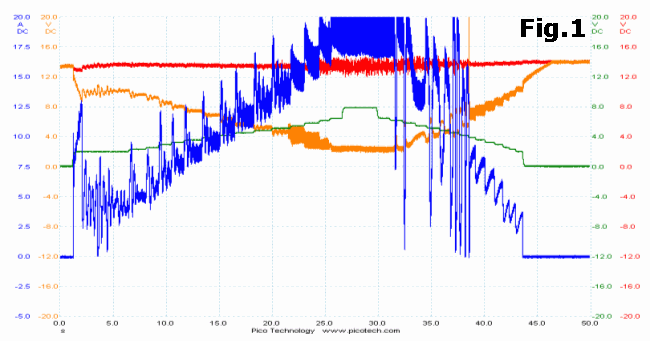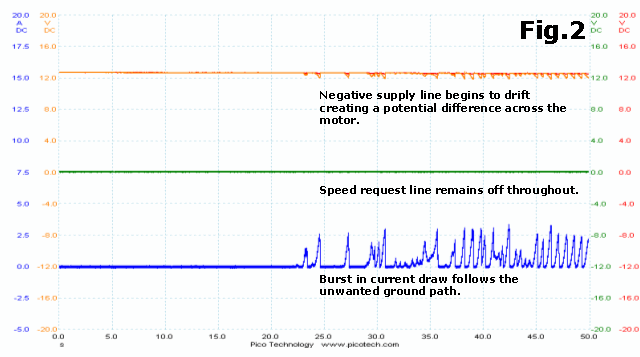
PicoScope 7 Automotive
Available for Windows, Mac, and Linux, the next evolution of our diagnostic scope software is now available.
| Vehicle details: | BMW X5 |
| Symptom: | Battery drain, Intermittent non-start |
| Author: | Nick Hibberd | Hibtech Auto-Electrical Diagnostics |
It’s not only on engine management within a vehicle where an oscilloscope delivers interesting finds: you can pretty much back-probe any wire and record a usable trace. You often find circuit operational characteristics that are not available in any OEM manual, and it’s this knowledge-building which is absolute gold. However, the only way to get truly proficient with an oscilloscope is to teach yourself, and this requires some investment of your time.
I’ve compiled a couple of recent investigations which are a world away from ignition or injection and demonstrate the oscilloscope as a versatile fault-finding tool. Any hardened “petrol head” may want to look away now.
This BMW had a complaint of intermittent no start caused by the vehicle battery discharging. Sometimes it would last two weeks and other times only last two days. The battery had already been replaced, twice, and the alternator overhauled and given a clean bill of health. The garage involved reported that each time the vehicle was checked for parasitic draw, none was found: a nightmare scenario, so where do you start?
BMWs are famous for their long shut-down times and purely from my own experience I expect somewhere between 16 and 18 minutes before sleep mode is reached. This wait-time is a real headache when trying to fault-find because, until you have allowed enough time to expire, you could end up chasing a problem that doesn’t exist. Furthermore, start tracing too early by pulling or replacing circuit fuses and you’re likely to reset a controller, adding more wait-time. Easy this, isn’t it?
Cut to the fault. Executing a simple parasitic draw test at the battery, I eventually picked up on sporadic surges in current draw that didn’t fit with all previous shutdown patterns, with the ammeter recording surges as high as 5 amps. Through different tracing techniques I narrowed the search to the AC system and in particular the interior blower.

The blower regulator receives constant battery power and relies on a single information line from the heater controller to increase or decrease motor speed. This information arrives at the regulator in the form of a varying DC voltage where 0 V equals full off. At rest the motor receives +12 V permanently and relies on the regulator to vary the ground level applied, thus varying the motor speed.
I hooked up the scope to the blower regulator and set it recording:

To obtain some suitable readings for analysis, Fig.1 was captured during a full speed sweep command. You can walk through the circuit operation starting with the speed request on CHC. As the request voltage increases, the regulator begins to supply a ground path for the motor creating a potential different across it; so the motor starts to turn. The speed request is incremental and likewise is the ground path applied to the motor.

Current flow on CHA follows a good trend as speed request increases, and closer inspection of commutation reveals a seemingly good motor. However, my attention was drawn to the part of the trace when speed was reducing, and current fluctuated as the regulator struggled to maintain a steady ground path. During this erroneous stage the speed request line held steady, which was evidence that the regulator was causing this particular anomaly. This was a real surprise as I didn’t hear or feel anything unusual through the air vents, so it was entirely down to the scope for spotting that. Although this shows that the regulator operation is incorrect during normal use, it hasn’t given anything conclusive towards our battery drain fault – yet.
An ammeter still monitoring parasitic draw coming straight out of the battery will give me a clear flag when the fault is present. So, hopefully, if the test plan so far has been correct, the scope should record some activity from the blower circuit.
The car was powered down as normal then left to settle. Waiting for a fault to appear can sometimes be a battle of patience, and this problem turned out to be no exception.

It took some time before the vehicle decided to fail. Then the meter reading started to swing high, giving me a clear indication the fault was now present. Fig.2 was subsequently recorded and shows the fault clearly. The ground path from the regulator unit is starting to leak into the motor circuit, allowing a current path through the motor that creates an excessive burden on the battery. If this is happening all night long, that 3.0 diesel lump is going to be very disappointed in the morning. A new blower regulator was installed.
As stated at the outset, the use of an oscilloscope and the interpretation of the display are very educational. I come back to the discovery of “circuit operational characteristics” and its role in knowledge building: you get out what you put in.
Pete Arthur
May 12 2016
Thank you Nick for a well-written and informative article. Your level of expertise is far greater than mine but I was able, for the most part, to understand and follow your narrative. I have a 2016 X5 that is six months old, but has only 250 miles on it. Since I drive it infrequently I keep a float charger attached to the battery terminals in the engine compartment. (I still haven’t located the battery; I have read that on the older X5 models it is located under the spare tire. This vehicle has run-flat tires and no spare. I have looked behind the second row seats, but if it’s there I haven’t found it.) When I brought my X5 home from the dealership I noticed the battery was heavily discharged (it drew a ten amp charge for about ten hours, then a two amp charge for a few hours after that). However, even if I leave the garage with a fully charged battery and drive the vehicle for any length of time I have noticed that the battery will still accept a charge after I bring it back to the garage. This leads me to believe that the battery is experiencing a net negative charge while it is being driven. I know that the utilization of electricity to power certain components (e.g. electric power steering and totally electric climate control) has increased substantially in newer vehicles; however, I wish the designers and engineers had incorporated an ammeter in the instrument cluster so I could monitor the battery’s state of charge (or discharge) while it is being driven. Just verbalizing my thoughts and concerns here. Thanks again for your article.
Jaima
November 14 2011
I too have the dreaded battery drain (2003 bmw x5 auto) I replaced the blower regulator aka fsu but still have a power drain?
I have read that there is another 2 possible causes, 1) the telephone module and 2) the radio/satnav unit, for number “1” pull fuse 74 in the boot/trunk and see how you get on.
terryg
August 27 2010
Nick i like your style,great article!
Nick Hibberd
August 16 2009
With repeated interest over one particular question I thought it appropriate to respond.
If you haven’t guessed by now the focus of these articles is the oscilloscope and its role played in a particular fault-find. With each article I try to include all the key points related to the investigation and make sure these technical facts come across in a reader friendly fashion, at the same time keep them light enough to be enjoyed by readers from all competency levels; this can be a hard balance to achieve. To include everything about everything in a short article just isn’t realistic.
To expand a little on chasing a parasitic draw; there’s no magical quick check here I’m afraid just good old fashioned leg work and thinking the problem through. In this example to get a trustworthy result I relied on many factors which include some of my past recorded notes, time spent determining a normal shut-down pattern, studying the wiring diagram, prioritising test routes where a 5+ amp draw would be possible, and yes isolating circuits by removing their fuse and dealing with the inherited problems. Not forgetting when the fault was absent trying different methods to recreate the fault. This whole process has little contribution to helping someone’s scope proficiency so for good reason it wasn’t elaborated on too much.
I hope no-one was expecting me to reveal a magic wand with a part number, I only need that on French cars.
Enjoy scoping,
Nick Hibberd
Dan Spatig
August 10 2009
I would also like to hear what techniques were employed.
Very interesting article, Thanks.
Pete Boyes
August 05 2009
We had this exact same fault on an 03 X5. I have a friend who is a BMW Master Tech and apparently it is common on early models. Later cars have modified motors.
colin
August 05 2009
once again nick proves the scope is as good as he is
steve jones
August 04 2009
Are you not really talking here of a data logger rather than a true oscilloscope?
Irving
August 04 2009
I too would be interested in these techniques. I have an Audi TT that exhibits a similar problem. Only really used at weekends, sometimes can be left 2 weeks and starts fine, other times a day or two and no juice in the battery. So far attempts to track the fault down by the garage have been NFF (typical ‘the computer says there’s no problem’ response).
Shaun O'Neill
August 04 2009
I would like to hear those techniques as well! You mentioned pulling fuses would not be wise on this application due to all the modules that would go off line then re wake up causing a longer wait. How did you isolate the ac system? Thanks for a great case study though!
Stewart Horn
June 30 2009
You have stated that Through different tracing techniques you narrowed the search to the AC system. Please can you tell me what these techniques were.